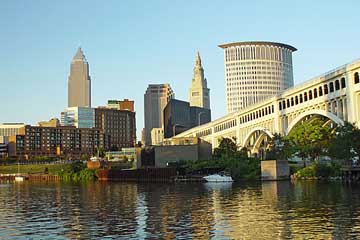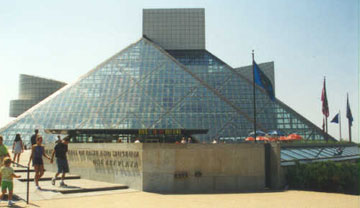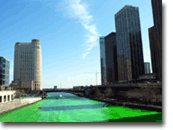Oct 24 2008
Rory Gallagher at the Cleveland Empire — 1991
 Located on the southern shore of Lake Erie and the banks of the Cuyahoga river, the city of Cleveland has an auspicious rock history. It was here that radio personality Alan Freed first coined the term “Rock and Roll” and put on the first Rock and Roll Concert, the Moondog Coronation Ball on March 21, 1952. Legendary frontman for Mott the Hoople, Ian Hunter pays homage to the man and his city in the 1979 classic, “Cleveland Rocks.”
Located on the southern shore of Lake Erie and the banks of the Cuyahoga river, the city of Cleveland has an auspicious rock history. It was here that radio personality Alan Freed first coined the term “Rock and Roll” and put on the first Rock and Roll Concert, the Moondog Coronation Ball on March 21, 1952. Legendary frontman for Mott the Hoople, Ian Hunter pays homage to the man and his city in the 1979 classic, “Cleveland Rocks.”
“All the little kids growing up on the skids are goin’ Cleveland Rocks”
When I first came over, with Mott, you’d do these clubs and nobody would turn up. Then you’d get to Cleveland and it would always be packed. Cleveland and Memphis were the first two towns that picked up on us, long before LA or New York–Ian Hunter.
 In 1986 Cleveland was chosen by the Rock and Roll Hall of Fame Foundation of New York City to be the home for the Rock and Roll Hall of Fame Museum. Designed by internationally renowned architect I. M. Pei, the museum finally opened its doors 9 years later on September 2, 1995, and touts itself as “the preeminent home for the celebration and study of rock and roll music.”
In 1986 Cleveland was chosen by the Rock and Roll Hall of Fame Foundation of New York City to be the home for the Rock and Roll Hall of Fame Museum. Designed by internationally renowned architect I. M. Pei, the museum finally opened its doors 9 years later on September 2, 1995, and touts itself as “the preeminent home for the celebration and study of rock and roll music.”
Unfortunately, despite his consummate skills as a musician and his legendary prowess on stage, Rory Gallagher has yet to be honored at this museum. This despite some kick ass shows he has done in Cleveland throughout the years; shows at, the Allen, the Agora and this month’s “boot of the month” venue, the Empire club!
The Empire
“It was one of the premiere clubs for shows around at that time.”–Bill Capuano from local Cleveland band, Blues Taxi.
The Empire opened in 1990 in downtown Cleveland, directly across from Jacobs Field, the home of major league baseball’s Cleveland Indians. The club was owned and operated by John and Tony Ciulla who had managed the shows at Peabody’s DownUnder, one of the pre-eminent concert clubs of the 80s in the Flats. The club had a seating capacity anywhere from 350 to 800, depending on the act, and would often exceed that limit much to the ire of the local Fire Department. Unfortunately, the club’s ability to “pack them in” would prove their downfall and the Empire lasted only 3 short years from 1990-1992. Tony Ciulla would later manage Marilyn Mason, while his brother, John, would become the Special Projects Director for the House of Blues Concert Series, Smirnoff Centre, Dallas, Texas.
There was always something crazy going on, but we just chalked it up to rock n roll. After a Buddy Guy overcrowding situation the fire department reduced the capacity. At that point we started a new venue, (and)…a sports bar took over for a few years after Empire–John Ciulla, former owner of the Empire.
 On March 21, 1952, the city of Cleveland put on the very first Rock and Roll concert, Allen Freed’s Moondog Coronation Ball. Almost 39 years to the day, on March 24, 1991, Rory comes to Cleveland and shows the town what Rock and Roll is Really about. This is one of the last concerts on Rory’s final tour of the United States. So kick off your shoes and have a listen as Rory tears down the Empire.
On March 21, 1952, the city of Cleveland put on the very first Rock and Roll concert, Allen Freed’s Moondog Coronation Ball. Almost 39 years to the day, on March 24, 1991, Rory comes to Cleveland and shows the town what Rock and Roll is Really about. This is one of the last concerts on Rory’s final tour of the United States. So kick off your shoes and have a listen as Rory tears down the Empire.

 Like many other major U.S. cities, Chicago has a large Irish-American population. By 1860 it was the fourth largest Irish city in America, but unlike their counterparts in New York, Boston, and Philadelphia, they have wielded tremendous political power disproportionate to their numbers. Chicago’s twelve Irish mayors have governed for more than 80 years, and on St. Patrick’s Day, the Chicago river is briefly turned green to honor the city’s Irish ethnicity. And what better way to honor the Irish than with a Rory Gallagher concert at one of Chicago’s finest nightclubs, the Aragon Ballroom!
Like many other major U.S. cities, Chicago has a large Irish-American population. By 1860 it was the fourth largest Irish city in America, but unlike their counterparts in New York, Boston, and Philadelphia, they have wielded tremendous political power disproportionate to their numbers. Chicago’s twelve Irish mayors have governed for more than 80 years, and on St. Patrick’s Day, the Chicago river is briefly turned green to honor the city’s Irish ethnicity. And what better way to honor the Irish than with a Rory Gallagher concert at one of Chicago’s finest nightclubs, the Aragon Ballroom!